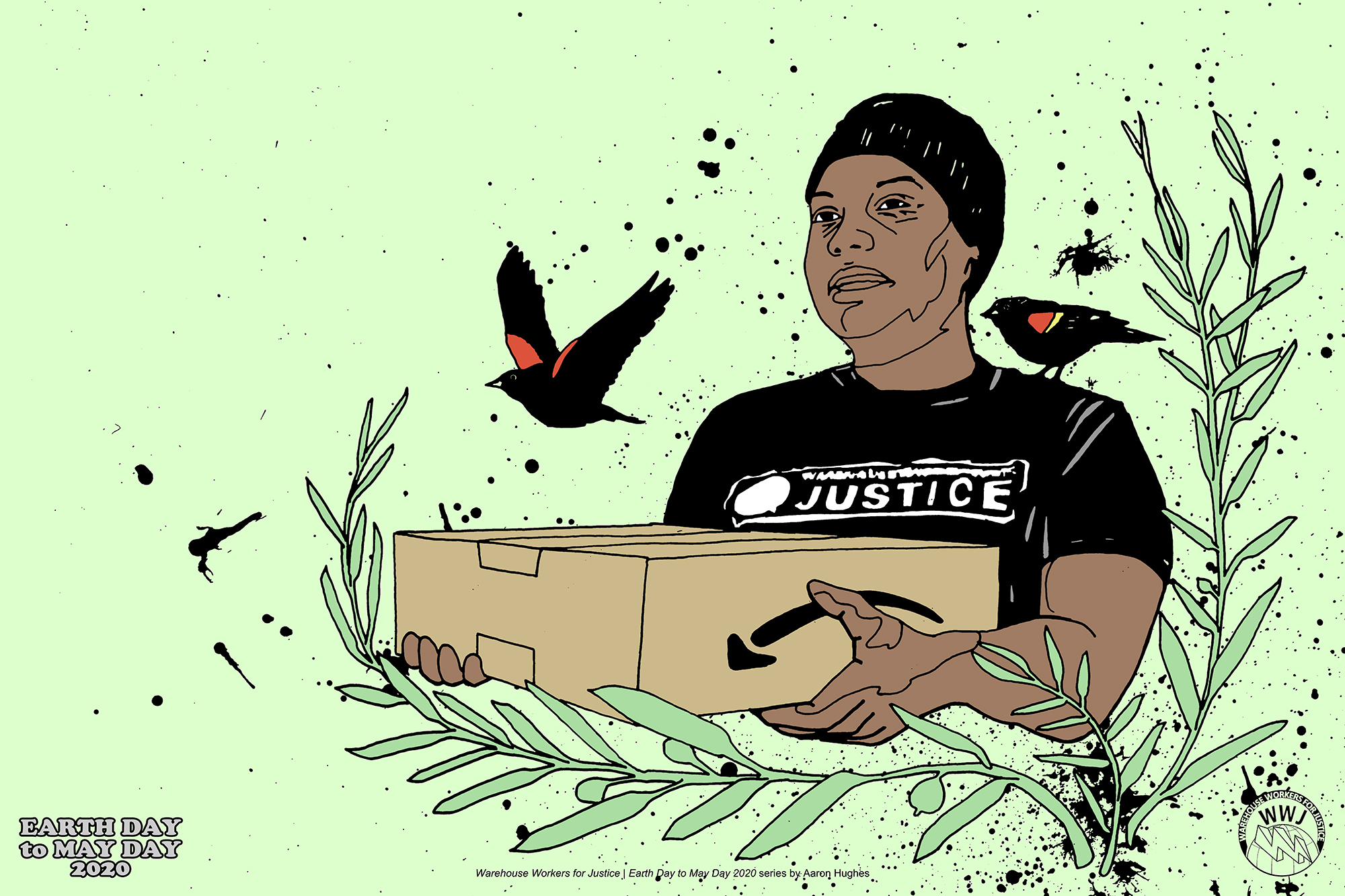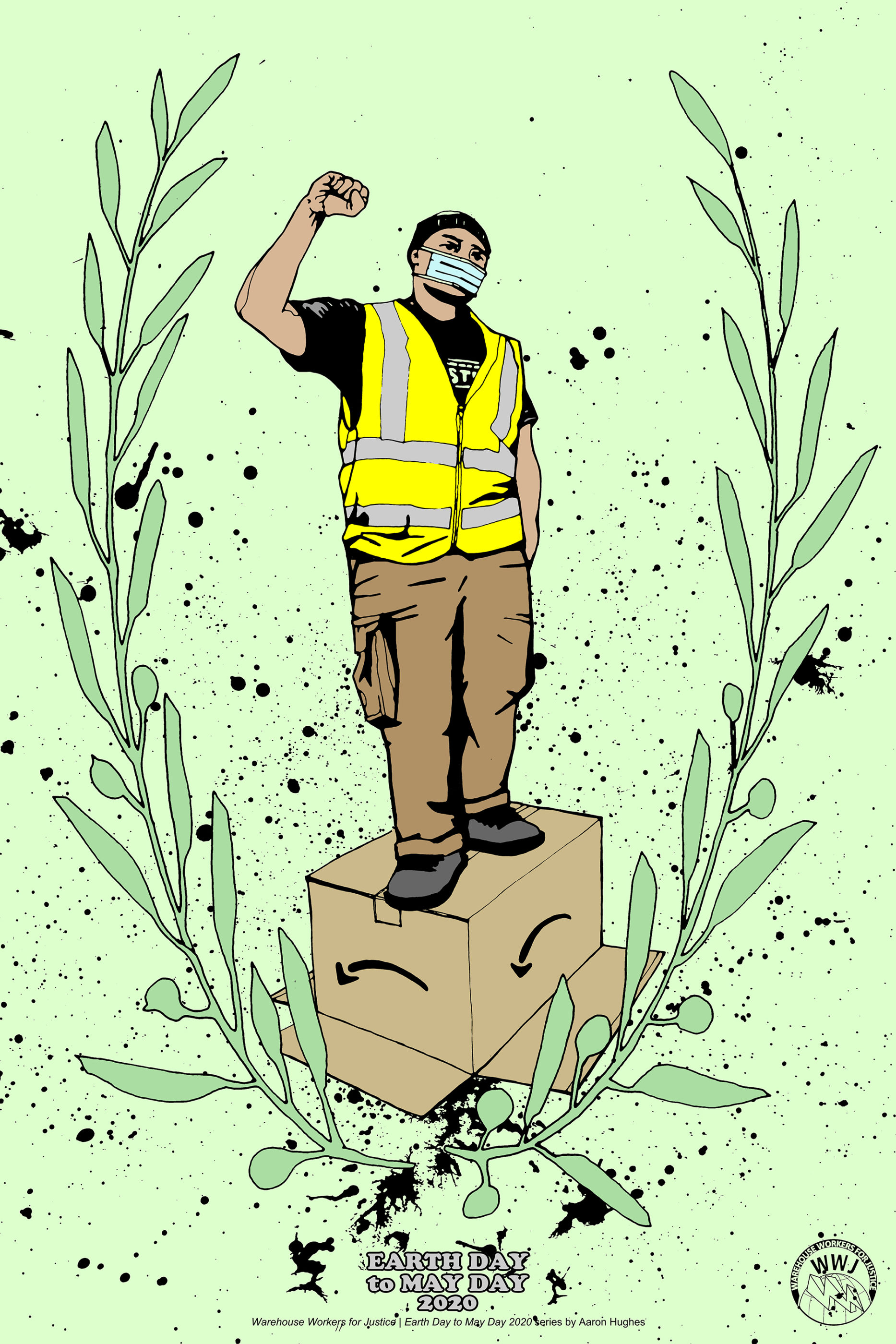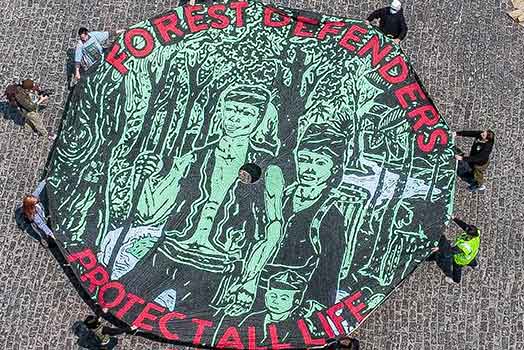
Aaron Hughes, Justice, 2020
The Earth Day to May Day Chicago coalition formed to unite labor, immigrant, community, and environmental justice organizations during the current public health, economic, and environmental justice crises. Their coalition statement begins,
Thousands of community members were preparing to take to the streets as part of the 50th anniversary of Earth Day, a mass mobilization to bring together labor, immigration, and environmental justice communities in Chicago. The coronavirus has drastically changed the political landscape in which we operate, and we will not be able to gather in the streets for nine days of action from Earth Day to May Day. However, the COVID-19 pandemic underscores the urgent need for strong community, labor, and environmental justice partnerships. In the coming weeks, we demand immediate, direct economic relief for community members and workers who need it most, rather than bailouts to corporations and shareholders. We now have an unprecedented opportunity to transform our economic system to center workers and end our dependence on fossil fuels through a just transition for our communities.
One of the coalition founding organizations was the Warehouse Workers for Justice (WWJ), a workers’ center fighting for stable, living-wage jobs in warehouses and distribution centers. As part of the Earth Day to May Day (EDMD) actions, WWJ Associate Director and organizer Roberto Clack asked me to do an “artist-in-residence” with WWJ. The hope for the residency was that I would make a series of graphics for the EDMD actions to lift up warehouse workers’ fight for dignity, and economic, racial, and environmental justice.
I produced ten designs, one for each day from Earth Day to May Day. Each graphic was about a member and/or action of the Warehouse Workers for Justice, using source photographs for specific details. I framed each image with olive branches as a gesture towards the climate justice and peace movements.
After the conclusion of the Earth Day to May Day actions I reached out to Roberto to get his thoughts on the actions and the graphics in hopes his reflections might be informative to future efforts.

Aaron Hughes, Demand Justice 1, 2020
Aaron Hughes (AH): Tell us a bit about your role in WWJ and the Earth Day to May Day Chicago coalition?
Roberto Clack (RC): I am the Associate Director of Warehouse Workers for Justice, a workers’ center located outside of North America’s largest inland port in Joliet, Illinois. In our community there are tens of thousands of warehouse workers and the who’s who of Fortune 500 companies. We fight for the rights of warehouse workers who are essential in the overall operation of our whole economy but have long been oppressed by retailers and corporate America.
Aaron Hughes, Demand Justice 2 & Organize, 2020
AH: Most groups that organize around worker rights don’t take action on climate change and the environment. Why was it important for WWJ to take action on the climate and be a part of founding the Earth Day to May Day coalition?
RC: The WWJ came into working on environmental issues in a roundabout way. The connections came out of the Northpoint Development, a 1.2 Billion Dollar warehouse development plan in Elwood, IL. People fighting the development wanted WWJ to speak out about the labor conditions in the warehouses. As we began to organize and take action around the issue we found that the local community was concerned about the impact warehouses would have on the local community. A big part of their concern was the environmental impact. I mean with over 10,000 trucks going in and out of the community everyday, air quality and asthma are a huge issue.
So WWJ decided to approach the development of the warehouses through a multissue perspective and connect the environmental, economic, and social justice issues. The Earth Day to May Day Chicago coalition was a direct extension of that work.

Aaron Hughes, Demand Justice 3, 2020
AH: Why was it important for WWJ and Earth Day to May Day Chicago coalition to work with artists?
RC: These are as trying times as we have seen with the COVID-19 crisis and many of the organizations that are part of the coalition have been tirelessly fighting for essential workers, our community, and the environment. People are getting sick, people are dying in our communities and we are experiencing an economic crisis that will likely only get worse over the coming months. Workers in warehouses and in the logistics industry are risking their lives to bring us the goods we need to survive.
Whether it’s visual, music or performance, art is going to be critical to surviving this trying time. We were grateful to have both visual and musical artists contribute and uplift our struggle and spirits. We will need artists to help us tell our stories, help us to mourn, process and celebrate the struggles we are facing and those still ahead of us.
AH: That makes me think of the Bertolt Brecht quote,
In the dark times
Will there also be singing?
Yes, there will also be singing
About the dark times.
You’ve been working with a lot of artists …
RC: Yeah, and you and I have worked together for a long time … starting in the anti-militarist movement against the Iraq War. While we know each other through this work, we both come from working class backgrounds and have always strongly valued working with labor organizations. The United Electrical Workers (UE) was the first union to support Iraq Veterans Against the War in Chicago and I eventually found my way to working in the labor movement closely with the UE.
There is a lot of history between all these organizations and the Earth Day to May Day Chicago coalition and the series of actions presented an opportunity to uplift two vital struggles, the fight for economic justice and the fight to save the environment.
I have gotten overwhelmingly positive feedback, people really appreciate your efforts and collaboration with the Earth Day to May Day coalition.
AH: I was really honored to be a part of the coalition and get to work with your team at the Warehouse Workers for Justice. Your members are on the frontlines of our failing system and are receiving the brunt of the health, economic and environmental impact. You all also hold a great deal of power. I mean, when warehouse workers walk out it has real economic impacts. They have the potential to bring the whole system to a grinding halt.
From my own organizing experience, I know how hard it is to organize and for people on the frontline to be aware of the power they have. I know that sometimes it’s hard to feel like people know about the struggles people face and their fights for dignity and justice. So I was honored to have this opportunity to work with you all to lift up the warehouse workers’ fight for justice.
In what ways do you think the graphics lifted up WWJ’s struggle? How did they help WWJ and the Earth Day to May Day Chiacago coalition make headway?
RC: When we originally planned both the art show and original series of events for the coalition, this was all to be in person, which included people being on the streets. Our efforts were born out of the global climate strikes, a world-wide, youth led movement which was one of the largest protests in human history. We expected the 50 year anniversary of Earth Day to surpass the massive events last fall and our goal was to agitate the labor movement to support the student strikers’ call to overhaul our economy to be more sustainable and more just for workers. With COVID-19 we had to entirely change our plans, including the Earth Day to May Day Chicago art show, which became a virtual series.
Our overall plans were severely affected but the art show allowed us to uplift our cause in a spirited way. People loved it and we were able to use the medium of art to draw the needed connections between labor, immigrant and environmental justice.
AH: Do you have a specific example?
RC: People loved lifting up the Green New Deal, while paying homage to local fights in Joliet and Elwood and the 2012 Walmart strike. The fight at Amazon is more important than ever and there are also ongoing local fights at smaller companies like Cushioneer that we were grateful were featured.
Together, the different graphics helped make the connection that the fight for labor and environmental justice are a fight that’s one and the same. We can’t have one without the other and art helps connect our struggles.

Aaron Hughes, Cushioneer Warehouse Workers For Justice, 2020
AH: Were there two or three graphics that were particularly powerful or important?
RC: This is a hard one. I loved the references to our fights in Elwood, both with the warehouse workers at Walmart and in support of the Just Say No To Northpoint fight being led by local community members. We need to grow our movements beyond urban cores and I appreciate uplifting working class fights in places like Joliet and Elwood.

Aaron Hughes, Just Say No to Northpoint, 2020
I also think the Green New Deal art is important, especially in the context of COVID-19. We are going to need massive intervention to help get past our current crisis and on the other side of this we need a strong Green New Deal for workers and our communities.

Aaron Hughes, Demand a Green New Deal, 2020
AH: Were there any specific goals the Earth Day to May Day Chicago coalition achieved or actions that you’d like to highlight?
RC: We were especially proud to be in solidarity and support our comrades in the Little Village Environmental Justice Organization who are leading the fight against the developer Hilco who is responsible for a recent environmental disaster in the community.

Grae Rosa, Rescind Hilco Tax Break Now, 2020
While much of WWJ’s work is focused in Will County and the suburbs, we were proud to relate our struggles with the fights for justice in places like Little Village and across diverse communities in Chicago. It was a big accomplishment to unite so many different groups across Chicagoland under a banner of immigrant, labor, community, and climate justice.

Aaron Hughes, Save Our People, Save Our Planet: People Not Polluter, 2020
AH: What is your hope for future artists’ involvement with WWJ and economic, racial, and climate justice movements?
RC: We plan to intensify our fights in workplaces and the community as we see no end in sight to this current crisis. We are looking to collaborate strongly with artists over the coming months and are currently planning future music events to help tell the story of our campaigns and struggles.
This will be a profoundly challenging time, we will need artists to help us survive and uplift our morale over the coming months of turmoil.

Aaron Hughes, Earth Day to May Day Strike, 2020

Download high resolution JPGs & PDFs of all the Warehouse Workers For Justice: Earth Day to May Day graphics by Aaron Hughes here.
Resources:
- Warehouse Workers For Justice: http://www.ww4j.org/
- Earth Day to May Day Chicago: https://medium.com/earth-day-to-may-day-chicago-coalition/earth-day-to-may-day-chicago-coalition-vision-statement-ff94e0b11e43









